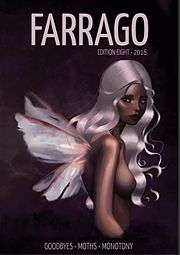Farrago (magazine)
|
Farrago, Issue 8 2016, front cover. | |
| Type | Student newspaper |
|---|---|
| Format | Magazine |
| Owner(s) | University of Melbourne Student Union |
| Editor | Danielle Bagnato, Sebastian Dodds, Baya Ou Yang and Caleb Triscari |
| Founded | 1925 |
| Language | English |
| Headquarters | Melbourne, Australia |
| Website |
www |
First published on 3 April 1925,[1] Farrago is Australia's oldest student newspaper.[2] Farrago is published by the Melbourne University Student Union.
Name
The term "farrago", from Latin, meaning "mixed cattle fodder",[3] means a confused variety of miscellaneous things. It has been used e.g. by Edward Tylor in his Primitive Culture.[4] The name is included in the motto (drawn originally from the Satires of Juvenal) Quidquid agunt homines nostri farrago libelli est — "whatever men do forms the motley subject of our page" which was written on the first issue of the famous eighteenth-century periodical Tatler.
Organisation
Up to four editors are elected annually and hold the shared title of Media Officer in the University of Melbourne Student Union, with the Union Secretary being the legally defined publisher. The editorship has been highly politicised in the past, and election campaigns are vigorous. Archives of Farrago are available at the Student Union's Rowden White Library and in the basement of the Baillieu Library on campus.
The newspaper's founders in 1925 included Randal Heymanson, who was the first editor,[5] and Brian Fitzpatrick, who was the first chief of staff.[6][7] Noteworthy editors in the past have included Geoffrey Blainey, Amira Gust, Claude Forrell, Ian Robinson, Morag Fraser, Henry Rosenbloom, Garrie Hutchinson, Ross McPherson, Colin Golvan, Lindsay Tanner, Peter Russo, Louise Carbines, Jim Brumby, Pete Steedman, Arnold Zable, Kate Legge, Nicola Gobbo, Cathy Bale, Christos Tsiolkas in 1987, and Nam Le in 1999. [8]
Voluntary student unionism
The implementation of voluntary student unionism in 2006 had a significant impact on the viability of student newspapers across Australia, compulsory student union membership fees having been the major source of income for most. "Christos Tsiolkas was editor in 1987, and he had a budget of $280,000; we have a budget of $58,000, and $55,000 of that will go on printing. We're quite lucky, we're a well-funded institution, and the University has provided transitional funding", said Farrago editor for 2009.[9]
Aims and content
Farrago is a magazine whose content is written entirely by students, which aims to be a voice, creative outlet and source of information for those who attend the University of Melbourne - irrespective of age, course and interests. Farrago encourages contributions from students in both written and/or illustrated forms, because without these it would not be an accurate representation of students at the university.
Farrago contains the following sections: Campus, Culture, Science, Society, Creative and Comment. Farrago also features regular columns from several student writers.[10]
References
- ↑ National Library of Australia. "Farrago / Melbourne University". National Library of Australia. Retrieved 27 October 2009.
- ↑ nikakisz (18 March 2009). "A bit of a Farrago". Retrieved 27 October 2009.
- ↑ "?".
- ↑ E. E. Evans-Pritchard, Theories of primitive religion. Oxford 1966:22.
- ↑ Humphries, Michael E. (2007). "Heymanson, Sir Sydney Henry (Randal) (1903–1984)". Australian Dictionary of Biography.
- ↑ Serle, Geoffrey (1996). "Fitzpatrick, Brian Charles (1905–1965)". Australian Dictionary of Biography.
- ↑ Selleck, Richard Joseph Wheeler (223). The Shop: The University of Melbourne, 1850-1939. Melbourne University Publishing. p. 662.
- ↑ Marc McEvoy (16 May 2009). "A brilliant way with words". The Sydney Morning Herald. Retrieved 1 November 2009.
- ↑ nikakisz (18 March 2009). "A bit of a Farrago". Retrieved 27 October 2009.
- ↑ http://farragomagazine.com
